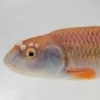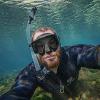Today found me working in Ware Shoals, SC, a town blessed with a park on a wonderful, shoaly stretch of the Saluda River. Whipped at the end of the day, I took me down to the river for a soak and half-hearted fin-chasing. I wasn't really concentrating and only turned up a couple adult fish, seagreen darters. The only thing I had for a phototank in the car was a 2.5 gallon glass aquarium. The still-in-the-bag lid was used as a paddle. I snapped a couple shots of the darters; usually I take a couple hundred.
Expected cruddy pictures, but they were actually quite good.
 SAM_1889.JPG 417.25KB
4 downloads
SAM_1889.JPG 417.25KB
4 downloads SAM_1890.JPG 418.52KB
4 downloads
SAM_1890.JPG 418.52KB
4 downloads SAM_1891.JPG 417.97KB
4 downloads
SAM_1891.JPG 417.97KB
4 downloadsWith the convention coming up, I'd like to take a lot of quite good photos. Is thin glass really that much better than thin plastic for pictures, or is this likely a fluke? Is the paddle that big a part of the results? I'll baby this 2.5 around the mountains if the results are going to be this improved for me. I'd consider it a worthwhile effort most times, until I can procure a bombproof, Uland special!














